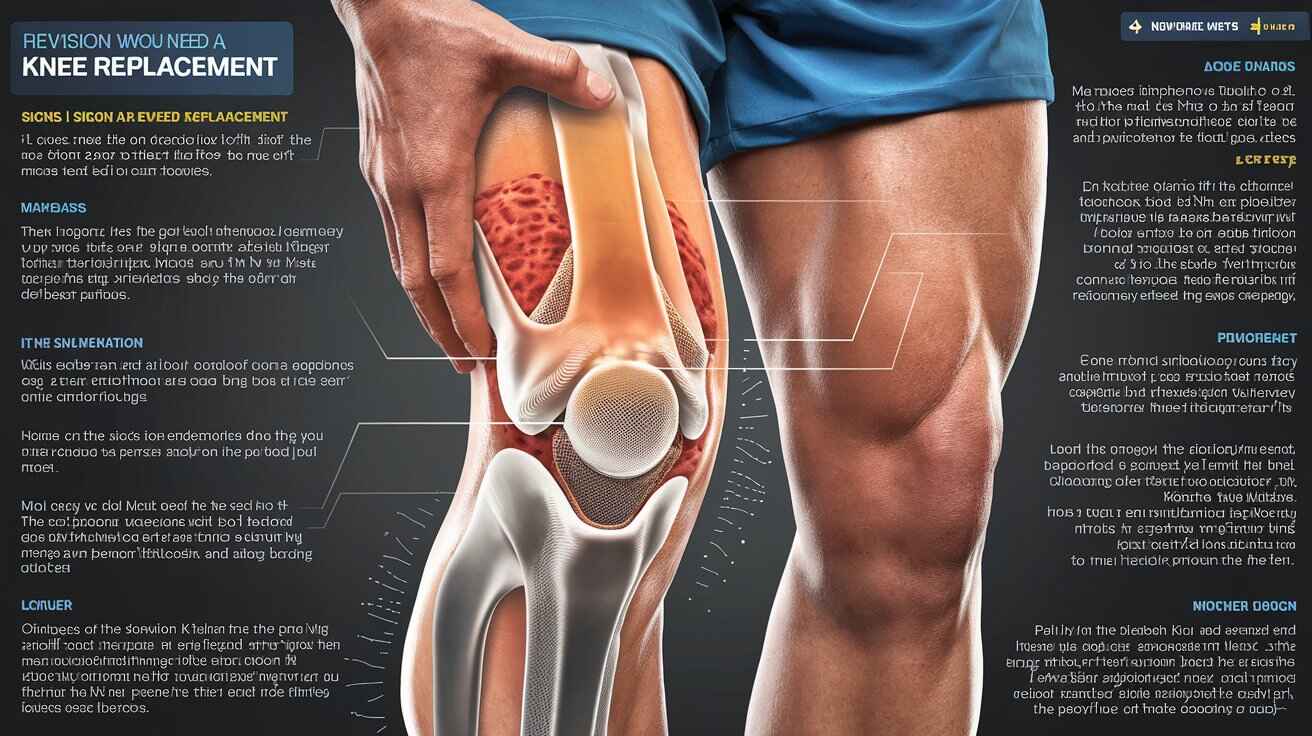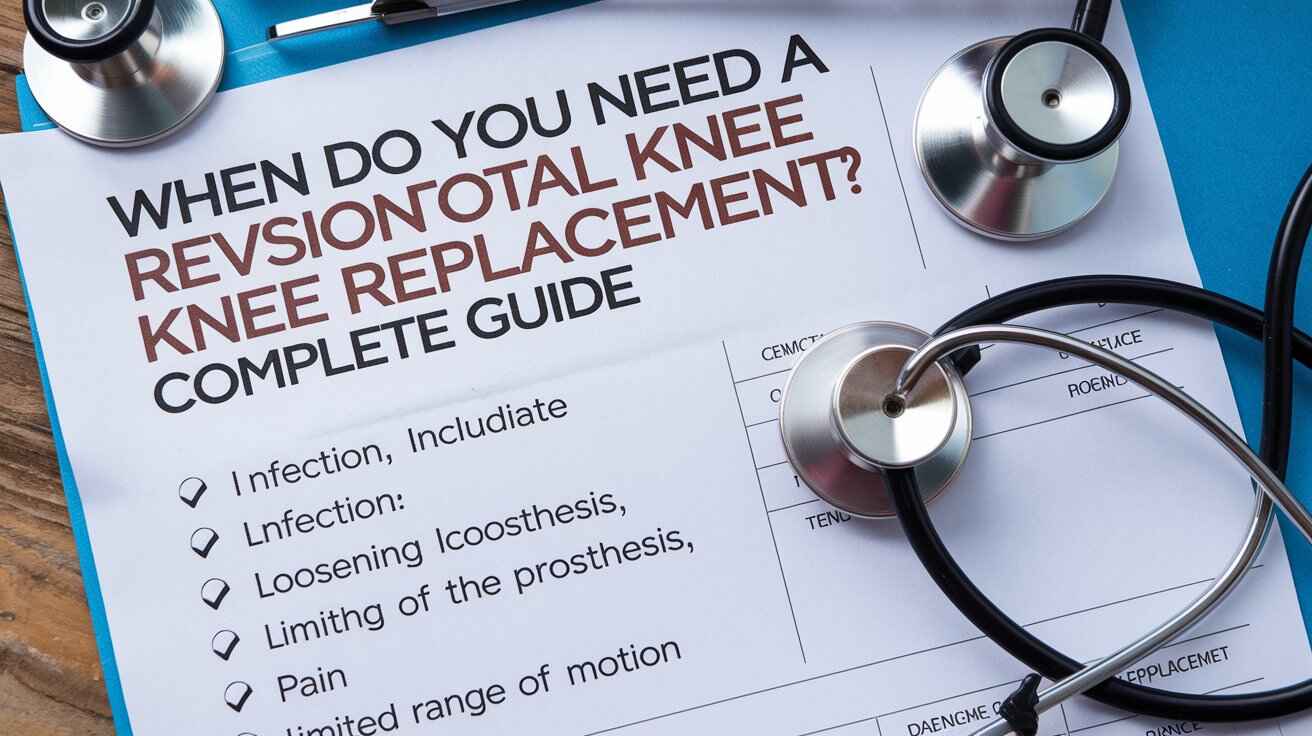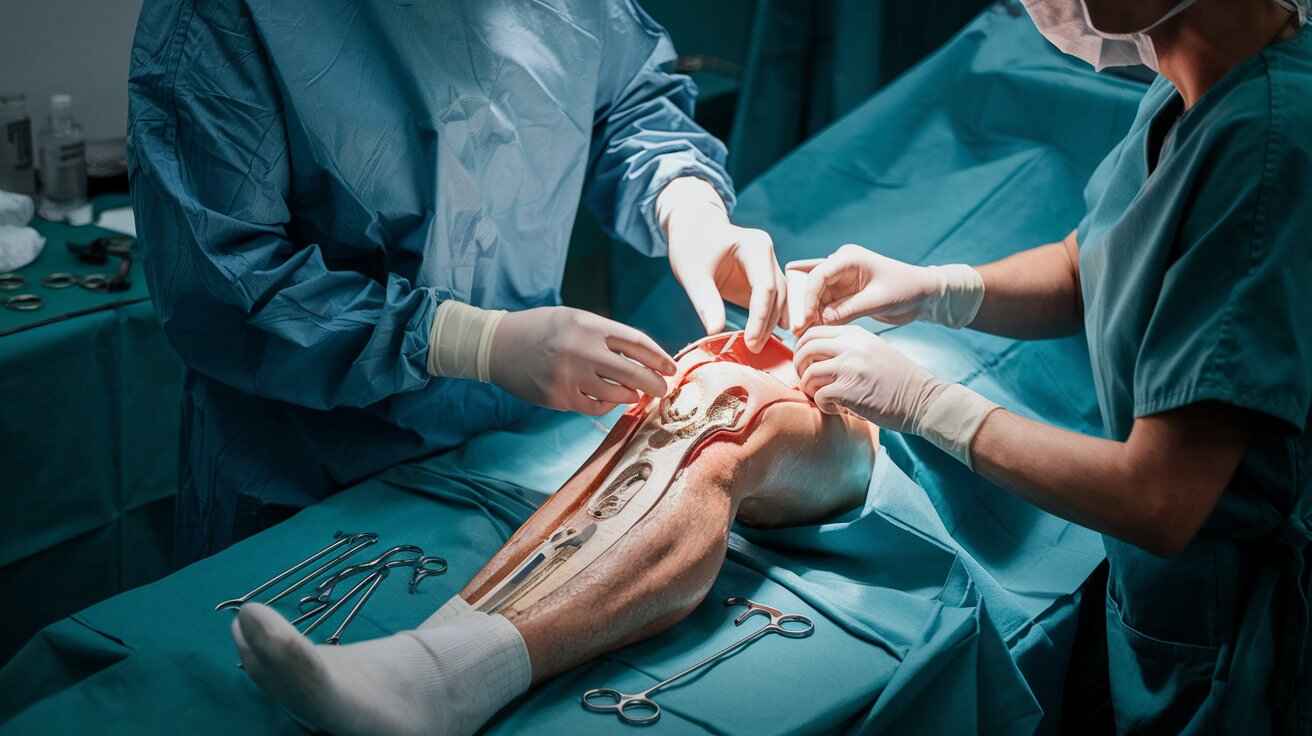If you've had a total knee replacement in the past but are experiencing renewed pain, decreased mobility, or other concerning symptoms, you might be wondering if something has gone wrong with your artificial joint. While primary knee replacements typically last 15-20 years or more, various factors can necessitate a second procedure known as a revision total knee replacement.
As a patient, knowing when follow-up surgery may be needed can help you make informed decisions about your health and mobility. In this comprehensive guide, Dr. Debashish Chanda explains everything you need to know about revision total knee replacement surgery—from recognizing the warning signs to understanding the recovery process and expected outcomes.
What Is a Revision Total Knee Replacement?
Definition and Basic Concept

A revision total knee replacement is a surgical procedure that involves removing some or all components of an existing artificial knee joint and replacing them with new ones. Unlike your first (primary) knee replacement, revision surgery is generally more complex because it deals with previously operated tissue, potential bone loss, and the removal of existing implants.
How It Differs from Primary Knee Replacement
Revision surgery differs from primary knee replacement in several key ways:
- Complexity: Revision procedures are typically more technically challenging and may take longer to perform.
- Component Design: Special revision implants with longer stems are often needed to provide additional stability.
- Bone Grafting: Sometimes, bone grafts are required to replace bone that has been lost around the failed implant.
- Recovery Time: The healing process may be longer compared to primary replacement recovery.
When Is a Revision Total Knee Replacement Necessary?
Understanding when you might need this procedure is crucial for maintaining your quality of life and preventing further complications. Here are the most common scenarios that might indicate the need for revision surgery:
Implant Wear and Loosening
Over time, the components of your artificial knee joint may wear down, just like any mechanical device. The plastic spacer (polyethylene) between the metal components can wear out, creating debris that leads to inflammation. Additionally, the implants may loosen from the bone, causing pain and instability when walking.
Signs of implant wear or loosening include:
- Pain that develops years after successful primary surgery
- A feeling of instability or "wobbling" in the knee
- Swelling that persists long after activity
- Decreasing the range of motion over time
Infection in the Prosthetic Joint
While relatively rare, infection remains one of the most serious complications following knee replacement. Bacteria can enter the body during the original surgery or via the bloodstream from infections elsewhere in the body.
Warning signs of knee replacement infection:
- Persistent pain and swelling
- Redness and warmth around the knee
- Fever or chills
- Drainage from the surgical site
- Increasing stiffness after a period of good function
Infected knee replacements typically require a two-stage revision process where the implant is removed, the infection is treated with antibiotics, and a new prosthesis is implanted once the infection has cleared.
Instability and Implant Failure
Sometimes, the knee replacement components can shift out of position, or the supporting ligaments may become damaged, leading to instability. You might experience a sensation that your knee is giving way or not supporting your weight properly.
Persistent Pain or Limited Function
If you continue to experience significant pain or limitations in movement despite appropriate rehabilitation after your primary knee replacement, a revision may be considered. However, Dr. Chanda will first rule out other causes of pain that might not be related to the implant itself.
Periprosthetic Fractures
Falls or accidents can cause fractures in the bone around your knee replacement. Depending on the location and severity of the fracture, revision surgery might be necessary to provide proper healing and restore function.
The Revision Total Knee Replacement Procedure
Pre-Surgical Assessment

Before recommending revision surgery, Dr. Chanda will conduct a thorough evaluation, including:
- Physical examination to assess pain, stability, and range of motion
- Imaging studies such as X-rays, CT scans, or MRIs to evaluate the position of components and condition of surrounding bone
- Blood tests are performed to check for indicators of infection.
- Joint aspiration (removing fluid from the knee) if infection is suspected
- Bone scans to detect areas of loosening or infection
This comprehensive assessment helps determine the specific cause of implant failure and guides the surgical approach.
The Surgical Procedure
Revision knee replacement is typically more extensive than primary surgery. Here's what generally happens during the procedure:
- Removal of old components: Dr. Chanda carefully removes the existing implants while preserving as much healthy bone as possible.
- Assessment of bone quality: Once the old implants are removed, the surgeon evaluates the remaining bone structure.
- Bone reconstruction: If there is significant bone loss, metal augments, bone grafts, or specialized components may be used to rebuild the bone foundation.
- Implantation of new components: Specialized revision implants, which often have longer stems to provide additional stability, are placed into the reconstructed bone.
- Testing stability: Before closing the incision, Dr. Chanda tests the new joint to ensure proper alignment, stability, and range of motion.
The entire procedure typically takes 2-3 hours, though complex cases may require more time.
Cost Factors for Revision Total Knee Replacement
The cost of revision knee replacement surgery varies widely depending on several factors:
Insurance Coverage
Most health insurance plans, including Medicare, cover revision knee replacement when deemed medically necessary. However, out-of-pocket expenses will depend on your specific insurance plan, deductibles, and copayments.
Geographic Location
Surgical costs vary significantly by region and facility. Urban centers and specialized orthopedic hospitals may charge more than rural facilities.
Complexity of the Procedure
Simple component exchanges will cost less than complex revisions requiring bone grafting, treating infections, or addressing significant bone loss.
Length of Hospital Stay
Revision surgery often requires a longer hospital stay than primary knee replacement, which adds to the overall cost.
Additional Services
Physical therapy, home health care, and assistive devices may add to the total cost of treatment and recovery.
It's important to discuss costs with both Dr. Chanda's office and your insurance provider before proceeding with surgery.
Benefits of Revision Total Knee Replacement

When successful, revision knee replacement can offer significant improvements to your quality of life:
- Pain relief: Addressing the underlying problems can significantly reduce or eliminate pain.
- Improved function: Many patients experience better mobility and stability after recovery.
- Enhanced quality of life: Reduced pain and improved function often translate to better sleep, mood, and overall well-being.
- Preservation of independence: Maintaining mobility helps preserve your ability to perform daily activities independently.
Risks and Complications
While revision knee replacement can be highly beneficial, it carries certain risks that are generally higher than with primary knee replacement:
- The risk of infection is increased during revision surgery.
- Blood clots can develop after knee surgery, resulting in deep vein thrombosis.
- Implant problems: There's a possibility of loosening, wear, or mechanical problems with the new implants.
- Nerve or blood vessel damage: The complex nature of revision surgery increases these risks.
- Continued pain or stiffness: Not all patients achieve complete pain relief or full range of motion.
- Need for additional surgery: Some patients may eventually need further revisions.
Dr. Chanda takes extensive precautions to minimize these risks, including the use of antibiotics, blood thinners, careful surgical techniques, and individualized rehabilitation plans.
Recovery After Revision Total Knee Replacement
Hospital Stay
After surgery, you should plan to stay in the hospital for a certain period of time. 2-4 days, although this may vary based on your overall health and the procedure's complexity.
Initial Recovery (0-6 Weeks)
The first six weeks after surgery focus on healing, protecting the surgical site, and gradually increasing activity:
- Pain management: You'll receive medications to manage discomfort.
- Physical therapy: Gentle exercises begin almost immediately to prevent stiffness.
- Walking aids: You'll likely need a walker or crutches initially, transitioning to a cane as strength improves.
- Proper wound care is essential for preventing infections. It is important to keep the incision clean and dry.
- Blood clot prevention: You may need to take blood thinners and wear compression stockings.
Intermediate Recovery (6 Weeks to 3 Months)
During this phase, you'll gradually increase activities and build strength:
- Progressive exercise: Your physical therapist will introduce more challenging exercises.
- Reduced reliance on walking aids: Many patients can walk without assistance for 12 weeks.
- Return to light activities: You may resume driving and light household activities.
- Continued monitoring: Follow-up appointments with Dr. Chanda will track your progress.
Long-Term Recovery (3 Months and Beyond)
Complete recovery may take between 6 to 12 months, depending on your individual circumstances.
- Continued strength building: Exercises focus on building muscle strength around the knee.
- Increasing activity levels: Most daily activities can be resumed, though high-impact activities are generally discouraged.
- Final results: Maximum improvement is usually achieved between 6-12 months after surgery.
Tips for Successful Recovery
- Follow your physical therapy program diligently. Consistency with exercises is crucial for rebuilding strength and range of motion.
- Maintain a healthy weight. Extra pounds put additional stress on your new knee components.
- Use assistive devices as recommended. Don't rush to discard walking aids before you're ready.
- Modify your home environment. Remove trip hazards and consider temporary modifications like a raised toilet seat.
- Attend all follow-up appointments with Dr. Chanda to ensure proper healing.
- Stay positive but realistic. Recovery takes time, and progress may be gradual rather than dramatic.
Frequently Asked Questions About Revision Total Knee Replacement
How long will my revised knee replacement last?
While there's no definitive answer, modern revision implants typically last 10-15 years, though many continue to function well beyond this timeframe. Factors affecting longevity include your activity level, weight, overall health, and the specific reason for the revision.
Will I need physical therapy after revision surgery?
Yes, physical therapy is essential after the revision of the knee replacement. Your therapy program may be more extensive than after primary replacement and could last 3-6 months.
Is revision surgery more painful than primary knee replacement?
Many patients report similar pain levels after surgery, though recovery may take longer. Advanced pain management techniques help control discomfort during the initial recovery period.
When can I drive after revision knee surgery?
Most patients can resume driving 4-6 weeks after surgery once they've stopped taking narcotic pain medications and have regained adequate strength and reaction time. Dr. Chanda will provide specific guidance based on your individual recovery.
Can I kneel after revision knee replacement?
Kneeling may be possible but often remains uncomfortable after knee replacement surgery. Special techniques can be learned to protect your knee if kneeling is necessary for activities you enjoy.
Conclusion: Making an Informed Decision
Revision total knee replacement, while more complex than primary surgery, offers a valuable second chance at pain relief and improved function when knee replacement components fail. Understanding when this procedure is necessary—whether due to implant wear, infection, instability, or other factors—helps you seek timely medical attention and achieve the best possible outcome.
Dr. Debashish Chanda focuses on complex revision procedures, offering a personalized approach to each patient's circumstances. By thoroughly evaluating your specific circumstances, he can determine whether revision surgery is appropriate and design a treatment plan tailored to your needs.
If you're experiencing problems with your knee replacement, don't hesitate to schedule a consultation. Early intervention often leads to less complicated surgery and better long-term results.






